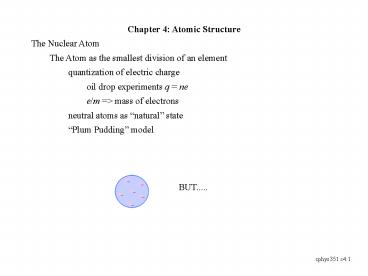Chapter 4: Atomic Structure PowerPoint PPT Presentation
1 / 23
Title: Chapter 4: Atomic Structure
1
Chapter 4 Atomic Structure The Nuclear Atom The
Atom as the smallest division of an
element quantization of electric charge oil drop
experiments q ne e/m gt mass of
electrons neutral atoms as natural state Plum
Pudding model BUT.....
2
Rutherford scattering (alpha particles from heavy
nuclei) test of plum pudding model a alpha
particles emitted in some radioactive
decays speeds 2E7 m/s q 2e, m 8000 x me
(a is a He4 nucleus)
3
Expected (from plum pudding) small scattering
angles, no back scattering
Results some larger scattering angles, including
some back scattering
The Nuclear Atom small heavy nucleus (99.8 of
atoms mass) with positive electric charge
1/100,000 radius of atom electron cloud gt
electrons orbit nucleus
4
Rutherford Scattering (theoretical results)
5
Rutherfords ingredients Newtonian Mechanics (F
ma) Coulomb Interaction gt Distance of closest
approach
Example The maximum KE of alpha particles from
natural sources is 7.7 MeV. What is the distance
of closest approach for a gold nucleus? (ZAu
79)
6
Electron Orbits planetary models of the atom for
the purposes of this discussion, take electron
orbits to be circular Hydrogen single electron
atom
Example 4.1 The ionization energy of Hydrogen is
13.6 eV (the energy required to liberate the
electron from the atom). Find the orbital radius
and speed of the electron in a hydrogen atom.
7
Problems with the nuclear atom accelerating
charges radiate orbits cannot be
stable!! considerable problems with atomic
spectra
8
Atomic Spectra emission line spectra (from thin,
hot gas or vapor) spectrum tube contains rarified
gas or vapor through which a high voltage is
discharged
typical emission spectra
Hydrogen
emission spectra vs. absorption spectra
Helium
Mercury
700nm
400nm
9
Hydrogen spectral series patterns in the spectra
10
Bohr Atom electron in orbit about nucleus atomic
size electron orbit radius (or see example 4.1)
0.053 nm compare de Broglie wavelength with
radius
11
Bohrs original hypothesis quantize angular
momentum of circular orbits
Bohrs hypothesis justified by de Broglie wave
theory
12
Energy in the Bohr Atom
free electron
E gt 0eV
E 0eV
n
. . .
. . .
n 3
E -3.40eV
n 2
E -13.6eV
n 1
13
Origin of Line Spectra Discrete Energy levels
conservation of energy photons
n f 1 -gt Lyman, n f 2 -gt Balmer, n f 3 -gt
Paschen, etc.
14
Example 4.2 An electron collides with a hydrogen
atom in its ground state(lowest energy) and
excites it to a state of n 3. How much energy
was given to the hydrogen atom in this inelastic
collision?
Example 4.3 Hydrogen atoms in state of high
quantum number have been created in the
laboratory. (a) Find the quantum number of the
Bohr orbit in a hydrogen atom whose radius is
0.0100mm. (b) What is the energy of a hydrogen
atom in this state?
Example 4.4 Find the longest wavelength present
in the Balmer series of hydrogen
15
The Correspondence Principle A new theory should
encompass an old theory where the old theory was
successful. Quantum theory approximates the
results of classical mechanics when quantum
numbers are large h -gt 0
16
Classical treatment of radiation from planetary
hydrogen frequency of emitted light frequency
of orbits ( harmonics)
Quantum transition from n -gt n- p with p ltlt n
17
Refining the Bohr Atom nuclear motion electron
and nucleus orbit each other (each orbit center
of mass). Two body problem gt center of mass
motion relative motion (with reduced mass)
18
Example 4.6 A positronium atom consists of an
electron and a positron. Compare the spectrum of
positronium to that of hydrogen
Example 4.7 Muons are elementary particles with
mass 207me and /-e of charge. A muonic atom is
formed by a negative muon with a proton. Find
the radius of the first Bohr orbit and the
ionization energy of the atom.
19
Atomic spectra Atoms have discrete set of allowed
energies ALL changes in atoms energy have to be
to an allowed state Absorption and emission
spectra from conservation of energy Franck-Her
tz Experiment inelastic scattering of electrons
by atoms -gtatom only absorbs energy to DE e
DV
DV
DV
20
The Laser bright, monochromatic, coherent light
source Excited State state above ground state
decays to lower states, with emission of photon
(or other mechanism for energy transfer). Metastab
le State sort of stable state state with a
longer life time than ordinary excited
states lifetime 1E-3 s vs. 1E-8 s for ordinary
states Three kinds of transitions
hn
hn
hn
hn
DE
hn
Induced Emission (Stimulated)
Induced Absorption
Spontaneous Emission
21
Light Amplification by Stimulated Emission
of Radiation
Energy levels for 4-level laser
22
Other considerations recycling inducing
photons and selecting lasing transition the
laser cavity Fabret-Perot Interferometer
standing waves Tunable Dye Lasers Semicondu
ctor Lasers Chemical Lasers
23
Chapter 4 exercises3,4,5,6,7,8,11,12,13,14,15,16,
18,19,21,22,29,30,31,32,33,35

